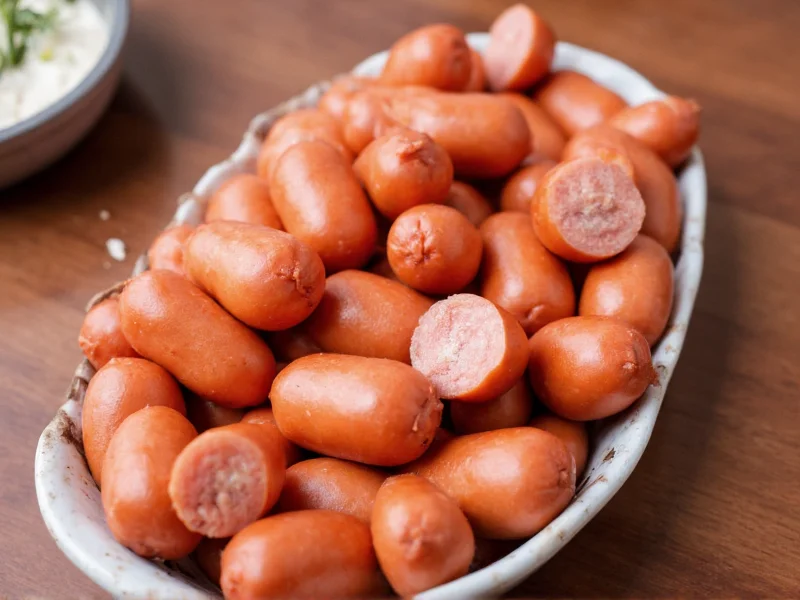These compact protein options have become kitchen staples for good reason. Unlike their full-sized counterparts, mini sausages cook faster, require minimal preparation, and offer versatile serving possibilities that appeal to both home cooks and professional chefs. Their popularity stems from practical advantages in meal planning and entertaining scenarios where portion control and presentation matter.
Understanding Mini Sausage Varieties
Mini sausages come in numerous varieties that cater to different dietary preferences and culinary applications. The most common types include:
| Type | Key Characteristics | Best Uses |
|---|---|---|
| Pork Mini Sausages | Traditional flavor, higher fat content | Breakfast dishes, hearty appetizers |
| Chicken Mini Sausages | Leaner profile, milder taste | Health-conscious meals, children's lunches |
| Vegetarian Mini Sausages | Plant-based ingredients, various protein sources | Vegan/vegetarian diets, allergy-friendly menus |
| Smoked Mini Sausages | Pre-cooked, distinctive smoky flavor | Cold platters, quick snacks, camping meals |
When selecting mini sausages for your specific needs, consider the cooking method you'll use and the flavor profile that complements your recipe. For example, smoked mini sausages work exceptionally well in cold applications like party trays, while fresh varieties offer more cooking flexibility for baked dishes.
Nutritional Profile Comparison
Understanding the nutritional differences between mini sausages and standard sausages helps make informed dietary choices. While nutritional content varies by brand and ingredients, mini sausages generally offer these characteristics:
- Calorie control: Individual mini sausages typically contain 50-100 calories each, making portion management easier than with full-sized sausages
- Protein density: Most provide 5-7 grams of protein per sausage, delivering substantial protein in a compact form
- Fat composition: Similar fat-to-protein ratio as regular sausages, though some brands offer reduced-fat versions specifically for mini varieties
- Sodium levels: Can be high (200-300mg per sausage), so check labels if monitoring sodium intake
For health-conscious consumers, chicken and turkey mini sausages typically contain 25-30% fewer calories and less saturated fat than pork varieties while maintaining similar protein content. When preparing mini sausages for children's meals, look for options with no added nitrates and lower sodium content.
Optimal Cooking Methods for Perfect Results
Mastering mini sausage preparation ensures delicious results every time. Unlike regular sausages, their smaller size requires adjusted cooking techniques to prevent overcooking:
Oven Baking (Recommended Method)
Preheat oven to 400°F (200°C). Arrange sausages on a parchment-lined baking sheet with space between each. Bake for 12-15 minutes until golden brown and internal temperature reaches 160°F (71°C). This method creates evenly cooked mini sausages with slightly crisp exteriors—ideal for party trays and meal prep.
Stovetop Cooking
Use a non-stick skillet over medium heat. Add sausages and cook 8-10 minutes, turning occasionally. For added flavor, include ¼ cup of liquid (water, broth, or apple juice) during the last 3 minutes to create steam and prevent drying. This technique works well for mini sausages recipes requiring integration with other ingredients.
Air Fryer Preparation
Set air fryer to 375°F (190°C). Cook mini sausages in a single layer for 8-10 minutes, shaking the basket halfway through. The air fryer method delivers restaurant-quality crispness with minimal oil—perfect for health-conscious mini sausages cooking time considerations.
Regardless of method, always verify doneness with a meat thermometer. Properly cooked mini sausages should reach 160°F internally while maintaining juicy texture. Overcooking causes them to become dry and shrink significantly.
Creative Culinary Applications
Mini sausages shine in diverse culinary contexts beyond simple standalone preparation. Consider these innovative uses that leverage their convenient size:
Appetizers and Party Foods
Create impressive party trays by arranging cooked mini sausages with dipping sauces like whole-grain mustard, honey mustard, or spicy aioli. For elegant presentation, thread them onto toothpicks with cheese cubes or wrap in crescent roll dough for pigs-in-a-blanket variations. These mini sausages recipes for parties require minimal effort but deliver maximum crowd appeal.
Breakfast Innovations
Incorporate mini sausages into breakfast dishes by adding them to egg muffins, breakfast casseroles, or as pizza toppings on English muffins. Their small size integrates seamlessly into breakfast burritos without overwhelming other ingredients—a perfect solution for kid-friendly mini sausages meals.
Main Dish Enhancements
Elevate pasta dishes, soups, and grain bowls by adding pre-cooked mini sausages during the final minutes of preparation. Their compact form distributes evenly throughout dishes, ensuring every serving contains protein. For family dinners, try mini sausages in tomato-based sauces over polenta or incorporated into fried rice.
Storage and Food Safety Guidelines
Proper storage maintains quality and ensures food safety for both opened and unopened packages:
- Refrigeration: Store unopened packages in original packaging until expiration date. After opening, transfer to airtight container and consume within 3-4 days
- Freezing: For long-term storage, freeze in original packaging (up to 2 months) or portion into freezer bags with air removed (up to 3 months). Flash-freeze individually on a baking sheet before transferring to bags to prevent clumping
- Thawing: Refrigerate overnight for best results. Never thaw at room temperature. For quick thawing, place sealed package in cold water, changing water every 30 minutes
- Leftovers: Store cooked mini sausages in shallow airtight containers for up to 4 days. Reheat to 165°F before serving
When purchasing mini sausages, check expiration dates and ensure packaging is intact with no signs of leakage. Discard any product with unusual odors, slimy texture, or discoloration. Following these mini sausages storage guidelines prevents food waste while maintaining optimal quality.











 浙公网安备
33010002000092号
浙公网安备
33010002000092号 浙B2-20120091-4
浙B2-20120091-4